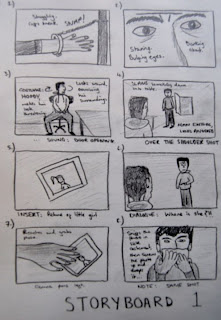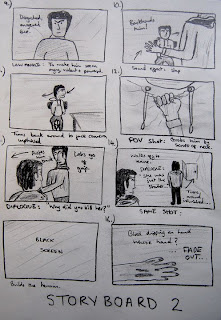The pace of the cuts in a thriller usually increases at parts of the film that contain more action, so that the shots are shorter and more ambiguous. This is so that the audience become more intrigued, and to build up the tension in these parts of the film. The pace usually builds up in the parts of the film with a villain in, this makes them more mysterious and unknown, and adds to the suspense.
Sound
Usually when something is being unreveiled in a thriller, like a major plot twist, or when the film becomes more action packed, fast paced non diegetic music will usually appear in the film to quicken the pace and build up tension.
Camera
Close up shots tend to be uses in thriller, usually on a victim before they are killed/captured, this makes their surroundings mysterious. This puts the audience on the edge of their seats, intending to frighten or thrill them, as they can not see what is behind, or anywhere around, the victaim. This means that when something drastic happens all of a sudden it will be more of a shock.
Lighting
The lighting in a thriller will be normal, except for some scenes, where it will become low key and dark, this creates a juxtapostion between the other scenes. This makes the normal everyday scenes, become more of a contrast, between darker and more twisted scenes, or crime scenes.
Characters
A thriller will often revolve around one main villain, who's identity will usually be unknown, untill the end of the film. This creates a lot of suspence throughout of the film, and keeps the audience thinking about where the film plot is going.
Thrillers often contain a 'damsel in distress', either towards the end of the film or throughout the whole film. This will be a character, usually a woman, as they stereotypically appear more vulnerable, who gets captured or put in danger and needs to be saved. This gives the audience someone to sympathise, and puts them on the edge of their seats, building up a lot of tension.
Plot
A thrillers' plot is usually quite realistic, or plays on realistic aspects, this makes it more scary as it more believable for the audience. For example it may be based around a crime, this makes them a lot more realistic than a Horror movie, and helps them relate to the characters in the movie.
Thrillers are usually set in realistic, identifiable locations. This is again, so that the audience can identify with the movie, and also so that the film builds up and takes you different darker locations, a contrast is created and shocks/thrills the audience.
Thrillers are usually set in realistic, identifiable locations. This is again, so that the audience can identify with the movie, and also so that the film builds up and takes you different darker locations, a contrast is created and shocks/thrills the audience.
The plot is usually ambiguous and mysterious, to keep the audience thinking, and to get them on the edge of their seats.

